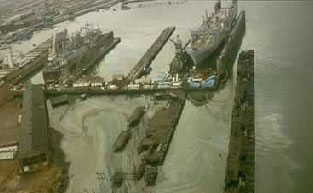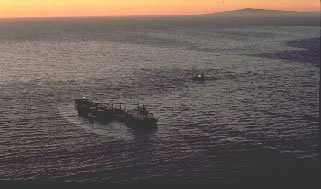Jonathan Bishop
Oil Spill Program Coordinator
California Coastal Commission
45 Fremont Street, Suite 2000
San Francisco, CA 94105
Santa Cruz Office:
(831) 427-4873
San Francisco Office:
(415) 904-5247
Fax:
(415) 904-5400
24-hour Emergency Oil Spill Notification:
(415) 693-8375
Oil Spill Program
What We Do
The California Coastal Commission Oil Spill Program is part of the Energy, Ocean Resources and Federal Consistency Division of the California Coastal Commission. Our roles in oil spill prevention, preparedness and response in California are diverse and challenging.
|
Oil Spill Prevention and Response - Guidance Document for Oil and Gas Project Applications |
We are committed to assisting federal, state and local agencies, citizens' groups, and the petroleum industry avoid the potentially catastrophic environmental and economic effects of a large-scale oil spill on the California coast, and ensure that when spills do occur, environmental impacts are reduced to the greatest extent possible.
Oil at the Port of San Francisco after the Cape Mohican spill, 1996 which spread outside the Bay and into Coastal Commission jurisdiction.
Oil Spill Program Statutory Authority
Our authority is prescribed primarily in two statutes:
California Coastal Act of 1976 and the Lempert-Keene-Seastrand Oil Spill
Prevention and Response Act of 1990.
The California Coastal Commission also exercises regulatory authority under
the Federal Coastal Zone Management Act for all of California’s
coastal shoreline areas except for the San Francisco Bay.
“Protect, maintain, and where feasible, enhance and
restore the overall quality of the coastal zone environment and
its natural and artificial resources.”
“Protection against the spillage of crude oil, gas, petroleum
products, or hazardous substances shall be provided in relation
to any development or transportation of such materials.”
-California Coastal Act, 1976
Oil Spill Prevention and Response Planning: What We Do
- Review coastal development projects related to energy and oil infrastructure
for compliance with the California Coastal Act and consistency with the Coastal
Zone Management Act;
- Attend all statewide and regional Harbor Safety Committee (HSC), Area
Committee and subcommittee meetings (e.g., dispersants, sensitive sites, Area Contingency Plan
update, oiled wildlife operations);
- Review regulations for oil spill prevention and response, and provide input
on these regulations’ consistency with Coastal Act regulations and policies;
- Review oil spill contingency plans for marine facilities located in the
coastal zone, and oil spill response plans for facilities located on the outer
continental shelf;
- Participate in the State Interagency Oil Spill Committee (SIOSC), SIOSC
Review Subcommittee and Oil Spill Technical Advisory Committee meetings and
assignments;
- Participate in studies conducted under SB 2040 that will improve oil spill
prevention, response and habitat restoration (e.g., offshore vessel traffic
studies, Southern California Offshore Lightering Workgroup);
- Participate in oil spill drills;
- Participate in the development of planning materials for oiled wildlife rehabilitation facilities located in the coastal zone.
Frequently Asked Questions About Oil Spill Response
Why Should the Coastal Commission Staff be Involved in Oil Spill Response?
To determine whether clean up activities are considered “development” and therefore require an emergency coastal development permit pursuant to the California Coastal Act;
For emergency permit purposes, determine whether clean up activities could adversely affect coastal resources;
To provide technical, jurisdictional and resource assessment assistance.
How Quickly Can an Oil Spill Response Permit Related Activity be Approved?
American Trader Oil Spill (Huntington Beach, California, 1990)
The Executive Director of the Coastal Commission can issue an emergency permit for clean-up or repair and maintenance activities determined to constitute development as defined in the Coastal Act. Issuing an emergency permit can be accomplished with a verbal approval on scene or by telephone.
Issued to the Responsible Party of the spill, an emergency permit requires compliance with any associated conditions, including the submittal of an application for a follow-up regular coastal development permit within a specific period of time (e.g., 60 days). The Coastal Development Permit will evaluate impacts to the site specifically related to the permitted clean-up or repair and maintenance activity, and not from the oil spill. Completion of the permit process does not interfere with the Natural Resource Damage Assessment (NRDA).
What Type of Oil Spill Response Activities May Require a Permit?
Oil spill response related activities that may require a coastal development permit include but are not limited to:
Grading (to level off terrain to a smooth horizontal or sloping surface) or construction within the coastal zone for temporary storage (i.e., storage tank for oil), access roads or staging areas;
Grading or clearing vegetation in sensitive resource areas;
Berming (to construct a temporary barrier to stop flow of oil or water) a river mouth or a lagoon;
Repair of pipelines and facilities under water or near sensitive habitats;
Construction of retaining walls as oil spill containment barriers.
What are the benefits of a Coastal Development Permit (CDP) for an Oil Spill Response Activity?
Protection of resources: Ensures protection of the resources through conditions and limitations set by the permit. In some instances, the CDP may be the only regulatory mechanism to implement other agencies’ resource protection and mitigation plans.
Prevention of future spills: Ensures that damaged facilities are properly repaired to prevent repeated oil spills.
Prevention of costly errors: Prevention of potentially costly mistakes during a spill response by limiting resource damage.
Links to Other Oil Spill Information
Incidents
BP Deepwater Horizon Oil Spill Response in the Gulf of Mexico (2010)
Federal
National Oceanic and Atmospheric Administration- Office of Response and Restoration
US Coast Guard 11th District (California)
US Coast Guard-National Response Center
US Environmental Protection Agency- Oil Spill ProgramUS Minerals Management Service- Pacific Outer Continental Shelf Region (go directly to their maps of active leases, platforms, and boundaries)
US National Response TeamCalifornia
California Department of Fish and Game. Office of Spill Prevention and Response
California Governor’s Office of Emergency Services
California State Lands CommissionCalifornia State Lands Commission. Marine Facilities Division
California Department of Conservation- Department of Oil, Gas and Geothermal Resources
California Resources Agency- Ocean Report 1997 State Agency Mandates and Responsibilities in the Marine Environment
University of California, Davis-Oiled Wildlife Care Network (OWCN)Regional
Pacific States/British Columbia Oil Spill Task Force
Regional Response Team- Region 9 (California, Nevada, Arizona)Here are some additional sites with information about oil spills and volunteer opportunities:
Gulf of the Farallones National Marine Sanctuary
Golden Gate National Recreation Area Cosco Busan Oil Spill
What is the Coastal Commission's Role in the Incident Command System?
The California Coastal Commission is a regulatory agency with permit authority. It is also a resource protection agency with the staff expertise to provide several types of assistance in the event of an oil spill. Listed below are a few examples of how the Coastal Commission staff may provide assistance to local, state and federal agencies and the responsible party in the event of an oil spill.
The Incident Command System is a scalable
organizational structure used to manage information and resources relating
to a particular event. An event can be anything from a Fourth of July Parade
to the Exxon Valdez oil spill. The system establishes a compartmentalized
structure to a response effort so that information can be quickly
transmitted from the source to the decision-makers, and resources can be
deployed and supported efficiently and effectively.
|
Incident Command System Roles
The Coastal Commission Oil Spill Program Staff fill key roles in the Incident Command System for oil spills impacting the California coastal and marine resources. We can provide assistance and information to the Unified Command on agency jurisdictions and permitting which will facilitate expeditious cleanup.
Command Section
Liaison/Agency Representation
Determine which spill response and clean-up activities require an emergency coastal development permit.
Assist with Coastal Commission jurisdictional determinations.
Command Staff Assistance
CCC Staff are trained in the Incident Command System and can serve as assistants to the Command Staff.
Planning Section
Situation Unit
CCC Staff has knowledge of coastal and marine resources and can assist in determining the spill response and clean-up options that will avoid or minimize adverse impacts to coastal and marine resources.
To Report an Oil Spill:
|
1-800-424-8802 |
|
1-916-262-1621 |
|
1-800-OILS-911 |
Our Contact Information:
Jonathan Bishop
Oil Spill Program Coordinator
California Coastal Commission
45 Fremont Street, Suite 2000
San Francisco, CA 94105Santa Cruz Office: (831) 427-4873
San Francisco Office: (415) 904-5247
Fax: (415) 904-5400
All photos courtesy of the National Oceanic and Atmospheric Administration.


